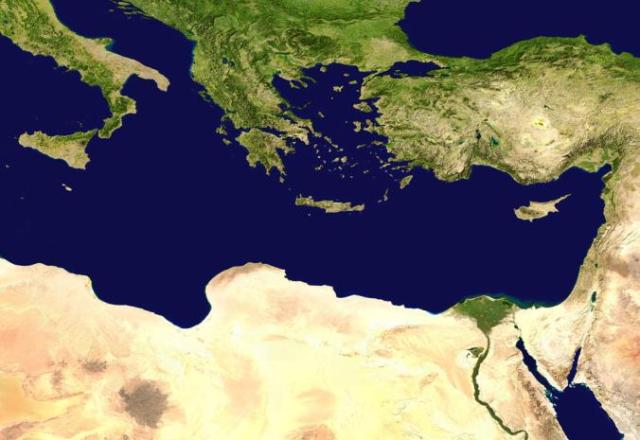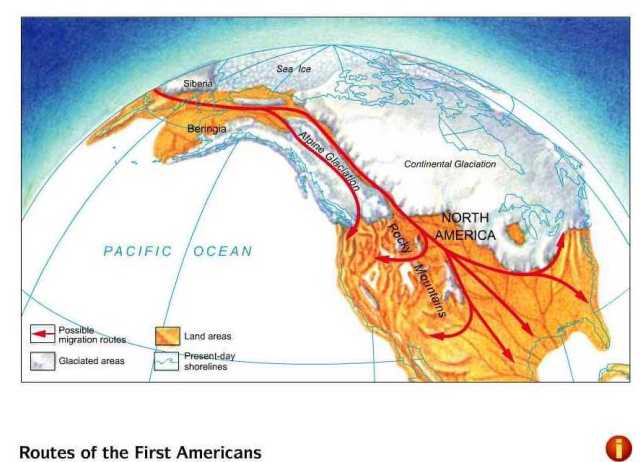We’ve long thought of ancient people as a little (or a lot) less sophisticated than we are. Maybe the March of Progress illustration is to blame, but we see the folks who came before us as kind of dull-witted. I mean, they didn’t have iPhones, right?
Worse is the assumption that they also lacked intelligence and emotional complexity, even language. This despite extensive evidence to the contrary, including new finds at Blombos Cave in South Africa, including engraved red ochre blocks, ochre mixing kits, shell beads, as well as bone and stone tools dated 70,000 to 100,000 years ago!
Let’s take a boat
And why do we assume that our ancient ancestors had to walk everywhere when evidence of their boating ability abounds?
Humans crossed open sea and reached Australia by boat 50 – 75,000 years ago. (Kimberly rock art shown in photo)

Thomas Stasser and Eleni Panagopoulou’s work on Crete uncovered stone artifacts over 130,000 years old. Their conclusion: modern humans were not the first to sail the Mediterranean. Neanderthals, or perhaps even earlier hominins arrived before them.

Map of Mediterranean – Crete at center
Even earlier evidence points to hominins’ ability to sail. Homo Floresiensis, the so-called “Hobbit People” for their diminutive size, braved treacherous deep sea waters to reach the island of Flores in what is now Indonesia. Some artifacts on the island are 800,000 years old.
England enjoyed at least four waves of colonizers, starting 800,000 years ago. The Boxgrove site on the southern coast yielded the oldest hominin remains: a leg bone and two teeth from what might be Homo heidelbergensis, considered the ancestor of both Homo neanderthalensis and Homo sapiens.
But in the Americas
On the other hand, the peopling of the Americas is always described as a plodding migration of humans along a single path. According to the theory most often taught in school, Ice Age hunters followed big game across what was then the land bridge between Siberia and Alaska, known as Beringia.
It wasn’t a new theory. Jose de Acosta of Spain first proposed it in 1590.
The Smithsonian vs. Clovis First
The Smithsonian Institution has had an interesting relationship with Clovis First. Although the first “Clovis” point was discovered in 1906 by George McJunkin, a self-educated African-American cowboy and former slave, it didn’t come to the attention of the Smithsonian until the 1920s when Jess Higgins, the director of the Colorado Museum of Natural History, found a similar point embedded in an extinct bison. In the 1930s more points like these were discovered near Clovis, New Mexico, which gave its name to the famous lithic style. The theory that grew out of these finds stated that the first Americans came across the Land Bridge from Asia and from there spread throughout the Americas.
Ales Hrdlicka, taking over from William Henry Holmes at the Smithsonian, used his considerable influence to squash any research into the Clovis theory. But the evidence kept piling up that modern humans were in North America at the same time as mammoths and Ice Age bison, about 13,000 years ago.

The Paleoindian Database of the Americas map above shows the distribution of Clovis points found in North America. The highest concentration is in the middle south.
So the push was on, with renegade western archaeologists pitted against the stodgy Eastern establishment. The theory eventually proved so popular that it was accepted as dogma. In a strange turn of events, anyone who questioned Clovis First was ridiculed by the archaeological establishment. Its force became so strong that any study that produced results conflicting with it was considered flawed. Scientists learned to ignore results that didn’t fit the model.
Thousands of maps like this one, courtesy of Bing, were created, presenting an over-simplified and probably incorrect picture of the peopling of the Americas.

Over the years, finds that conflicted with Clovis First kept coming in. Clovis points are concentrated in the southeastern part of the USA, not the west, as would be expected from the Clovis First migration theory.
In yet another strange turn-around, Dennis Stanford of the Smithsonian Museum of Natural History now claims there was never any evidence of Clovis points originating in Siberia. He now claims that the points are Solutrean, and the colonizers came from northern Spain to the eastern coast of North America.
And now to South America
When Tom Dillehay came up with a date of 14,800 years ago for the Monte Verde site in Chile, the archaeological community, in a fit of collective panic, said they simply couldn’t accept evidence that refuted their favorite theory. No site in South America could predate the opening of the ice sheets in North America.

CREDIT: KENNETH GARRETT/NATIONAL GEOGRAPHIC SOCIETY, 1997 TOM D. DILLEHAY, STANDING, AND MARIO PINO LEADING A SCIENTIFIC TEAM THAT FOUND EVIDENCE IN MONTE VERDE IN CHILE THAT HUMANS HAD BEEN IN THE NEW WORLD 1,300 YEARS BEFORE PREVIOUSLY THOUGHT.
And now, Dillehay has published a new paper in PLOS One, with dates from a different section of the Monte Verde site, establishing human presence there 18,500 years ago.
This brings up the possibility that the direction of the migration arrow in the old model was dead wrong. Maybe people showed up in South America and then moved north.

But here’s the strangest part of this odd drama: Why, when we accept seafaring relatives in the Mediterranean as far back as the Neanderthals – maybe farther – can’t we accept seafaring explorers who arrived in the Americas? Not just coastline huggers. True seafarers, excellent navigators from the South Pacific.
Maybe they were outlaws or people who got lost at sea. Or maybe they just had to see what was out there.

That’s the premise of the second book in my series, Past the Last Island. A group of explorers, driven away from their homeland by natural disasters, purposely sets out into the open ocean to find whatever lies beyond the edge of the world. I believe that’s a human trait. It’s what took us to the moon and someday, I hope, to Mars and other planets.
If we grant the people from long ago the same intelligence and complexity we value in ourselves, we open up new possibilities in our history, and our collective story becomes that much richer.
(The next big shake-up in the ancients’ world is going to come from China. Stay tuned.)
Sources and interesting reading:
“Blombos Cave,” Wikipedia, https://en.wikipedia.org/wiki/Blombos_Cave
Bower, Bruce. “Ancient Hominids Took to the Seas,” Science News, 27 November 2012, news.discovery.com/human/evolution/ancient-hominids_sailors_seas.htm
“Clovis: Why the Controversy?” The Bradshaw Foundation, http://www.bradshawfoundation.com/journey/clovis.html
Curry, Andrew. “Finding the First Americans,” The New York Times, 19 May 2012, http://www.nytimes.com/2012/05/20/opinion/sunday/who-arrived-in-the-americas-first.html
Dillehay, Tom, and others. “New Archaeological Evidence for an Early Human Presence at Monte Verde, Chile,” PLOS One, 18 November 2015, http://journals.plos.org/plosone/article?id=10.1371/journal.pone.0141923.
Dixon, Jim, “Vicariant models for the initial colonization of North America,” People Colonizing New Worlds, 1st Harvard Australian Studies Symposium, 17-18 April, 2009
“First Americans arrived 2500 years before we thought,” New Scientist, Daily News, 24 March 2011, http://www.newscientist.com/article/dn20287-first-americans-arrived-2500-years-before-we-thought?DCMP=OTC-rss&nsref+online-news
Gugliotta, Guy. “When Did Humans Come to the Americas?” Smithsonian Magazine, February 2013, http://www.smithsonianmag.com/science-nature/when-did-humans-come-to-the-americas-4209273/
“Homo Floresiensis,” Human Origins, Smithsonian Museum of Natural History, http://humanorigins.si.edu/evidence/human-fossils/species/homo-floresiensis
Jones, Tim. “100,000 Year-Old Incised Ochre Found at Blombos Cave,” Anthropology.net: Beyond bones and stones, 12 June 2009, http://anthropology.net/2009/06/12/100000-year-old-incissed-ochre-found-at-blombos-cave/
Hawks, John. “Did humans approach the southern tip of South America more than 18,000 years ago?” John Hawks Weblog, 19 November 2015, http://johnhawks.net/weblog/reiews/archaeology/america/dillehay-monte-verde-2015.html
Mann, Charles C. “The Clovis Point and the Discovery of America’s First Culture,” Smithsonian Magazine, November 2013, http://www.smithsonianmag.com/history/the-clovis-point-and-the-discovery-of-americas-first-culture-3825828/?no-ist
Meltzer, David. “Why don’t we know when the first people came to North America?” American Antiquity, 54(3), 1989, 471-490. (This article is interesting but out of date.)
Map of Clovis points distribution, PIDBA, Paleoindian Database of the Americas, web.utk.edu/~dander19/clovis_continent-647kb.jpg
“Neanderthals May Have Sailed to Crete,” Discovery.com, 13 December 2012, newsdiscovery.com/history/archaeology/Neanderthals-sailed-Mediterranean-121115.htm
Pringle, Heather. “Primitive Humans Conquer Sea, Surprising Finds Suggest, National Geographic, 17 February 2010, news.nationalgeographic.com/news/2010/02/100217-crete-primitive-humans-mariners-seafarers-mediterranean-sea/
Simmons, Alan. “Extinct pygmy hippopotamus and early man in Cyprus,” Nature, 333, 09 June 1988, 554-557, hhtp://www.nature.com/nature/journal/v333/n6173/abs/333554a0.html
“Upside-Down Map of the Americas” Peregringo blog, http://peregringo.com/?attachment_id=315
Wayman, Erin. “The Top Five Human Evolution Discoveries from England,” Smithsonian Magazine 25 July 2012, http://www.smithsonianmag.com/science-nature/the-top-five-human-evolution-discoveries-from-england-6792571/
Wilford, John Noble. “On Crete, New Evidence of Very Ancient Mariners,” The New York Times, 15 February 2010, http://www.nytimes.com/2010/02/16/science/16archeo.html
Great post. Great Segway to your book.
Sent from my iPad
>
Thanks very much, Carol!
Enjoyed the information, as always.
Thanks, Ron!